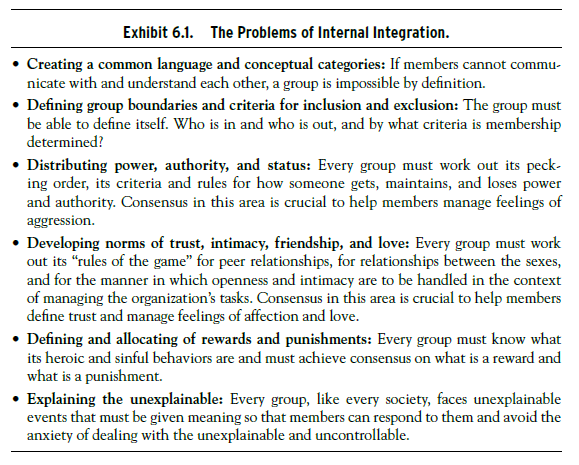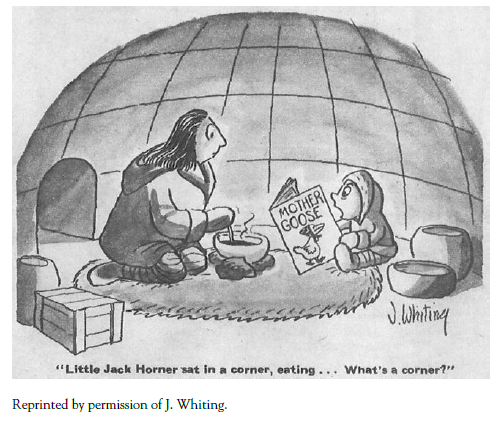To function as a group, the individuals who come together must establish a system of communication and a language that permits setting goals and interpreting and managing what is going on. The human organism cannot tolerate too much uncertainty or stimulus overload. Categories of meaning that organize perceptions and thought filter out what is unimportant while focusing on what is important. Such categories not only reduce overload and anxiety but also are a necessary precondition for any coordinated action. Language provides those categories.

Two children on a see-saw need some verbal or nonverbal means of signaling when to push and when to relax, or how far back to sit if their weight is different, or how fast to move. Members of a founding group coming together to create a new organization need to learn about each other’s semantic space (even if they start with a common basic language, such as English) to determine what they mean by such abstractions as “a good product,” of “high quality,” produced at “low cost,” to get into the “market” “as rapidly as possible.” At a more mundane level, the cartoon of the Eskimo mother makes the point well.
If several members of a group are using different category systems, not only will they not agree on what to do, but they also will not even agree on their definition of what is real, what is a fact, when something is true or false, what is important, what needs attention, and so on. Most communication breakdowns between people result from their lack of awareness that at the outset, they are making basically different assumptions about meaning categories.

For example, in my role as a consultant to a small family-owned food company, I asked some managers whether they experienced any “conflicts” with subordinates, peers, or superiors in their daily work. Unless I happened to be talking to a particularly disgruntled person, I usually elicited an immediate and flat denial of any conflict whatsoever. This response puzzled me because I had been called in by the president to help figure out what to do about “severe conflicts” that members of the organization were perceiving and experiencing. I finally realized that I was assuming that the word “conflict” was a generally understood term referring to any degree of disagreement between two or more people, and that conflict was a normal human condition that is always present to some degree.
My interviewees, on the other hand, held two quite different assumptions. In their view, (1) the word conflict referred to a severe disagreement that is difficult if not impossible to reconcile (a different semantic interpretation of the word itself), and (2) conflict was “bad” in the sense that a person who has conflicts is not managing well. After I realized that different semantic assumptions were at the root of the communication problem, I could change my inquiry to: “Can you tell me about the things that make it easy or hard for you to get your job done.” If any evidence of interpersonal “disagreements” began to surface, I made explicit my own assumption that such disagreements were, in my view, completely normal in organizations. I then often got vivid and detailed stories of severe “conflicts” and, in subsequent discussions, found that I could use the word conflict itself without further misunderstanding or defensiveness. In this example, my clients and I were building a common meaning system for our own work.
In this same organization, I observed in group meetings that the president often got angry with a member who was not contributing actively and began to draw conclusions about the competence of that member. The president assumed (as I learned later by asking about the situation) that the silence meant ignorance, incompetence, or lack of motivation. The silent member, it turned out, was usually ready to make a presentation and was very frustrated because he was never called on to give it. He assumed that he was not supposed to volunteer, and he began to believe that his boss did not value him because he was not called on. If their different assumptions about the meaning of silence were not brought into the open, the danger was that both would validate their own incorrect assumption, thus setting up a classic case of a self-fulfilling prophecy. In this group, the absence of a consensually validated communication system undermined effective action. A total group culture had not yet formed, though various subgroups might already have been operating on shared assumptions, such as “Our boss does not value our contributions.”
Critical conceptual categories are usually built into the basic language a group uses. Thus, English speakers learn through English words the major cultural categories of the Anglo-Saxon cultural tradition. For example, the word management reflects the proactive, optimistic, pragmatic approach that characterizes the U.S. culture. It is a surprise to many people who speak only English that a comparable word does not exist in other languages, such as German. Even more important, if the word does not exist, the concept also may not exist in the same sense. For example, in German there are words for leadership, leading, and directing; but managing, as English speakers mean it, does not readily translate either as a word or as a concept.
One of the cultural traps that new organizations face is the failure to note that new members come from very different subcultures and need to establish a common meaning system within the common language. When there are new members from other macrocultures, the problem is likely to be recognized immediately, leading founders and leaders to pay closer attention to building a common language and common meanings through activities that can best be thought of as “cultural islands” in which the primary focus is on language and meaning.
In summary, a common language and common conceptual categories are clearly necessary for any kind of consensus to be established and for any communication to occur at all. This common understanding begins with the categories of action, gesture, and speech that are often provided by the person who brought the group together or by the more active members of the group once it is together. Because the members are usually all from the same host culture, a common language is initially available. However, as the group matures, it invests common words with special meanings, and what certain words really mean ultimately becomes one of the deepest layers of that group’s culture. From the outsider’s point of view that common language is then labeled as “jargon” and becomes difficult to decipher. With growing globalism and occupational complexity, more groups will be multicultural, requiring special efforts on the part of leadership to create cultural islands in which those differences can be explored. More will be said about this in Chapters Twelve and Twenty-One.
Source: Schein Edgar H. (2010), Organizational Culture and Leadership, Jossey-Bass; 4th edition.

17 May 2021
15 May 2021
17 May 2021
15 May 2021
15 May 2021
15 May 2021